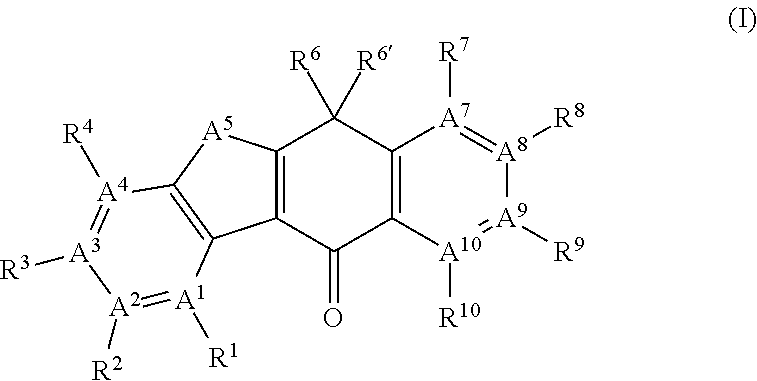Tetracyclic compound
- Summary
- Abstract
- Description
- Claims
- Application Information
AI Technical Summary
Benefits of technology
Problems solved by technology
Method used
Image
Examples
example 1
7-Methoxy-1,1-dimethyl-3,4-dihydro-1H-naphthalen-2-one
[0744]
[0745]7-Methoxy-3,4-dihydro-1H-naphthalen-2-one (Compound A1, 209 g, 1.18 mol), tetrabutylammonium hydrogen sulfate (40 g, 0.118 mol) and methyl iodide (162 g, 2.60 mol) were suspended in THF (500 ml) at room temperature. Under stirring, the mixture was added with 50% aqueous solution of potassium hydroxide (400 g) over 5 min. Reflux occurred as the inner temperature rapidly increases. Once the inner temperature stopped to increase, stirring was continued for 45 min. The reaction solution was diluted with distilled water (1 L) and extracted twice with CPME (1.5 L). The combined organic layer was washed (distilled water 1 L×3), dried over anhydrous sodium sulfate, and concentrated under reduced pressure. The resulting crude product was recrystallized with MeOH (1 L) and distilled water (500 ml) to obtain the title compound as a colorless needle-like crystal (177 g, 73%).
[0746]1H-NMR (400 MHz, CDCl3) δ: 1. 43 (6H, ...
example 2
Compound A3-1
Compound A3-2
3-Bromo-8-methoxy-6,6-dimethyl-6,11-dihydro-5H-benzo[b]carbazole
1-Bromo-8-methoxy-6,6-dimethyl-6,11-dihydro-5H-benzo[b]carbazole
[0748]
[0749]7-Methoxy-1,1-dimethyl-3,4-dihydro-1H-naphthalen-2-one (Compound A2, 66.2 g, 324 mmol) and 3-bromophenylhydrazine hydrochloric acid salt (71.0 g, 318 mmol) were dissolved in AcOH (350 ml) and refluxed under stirring for 6 hr. The reaction solvent was removed by distillation under reduced pressure to obtain the crude product as a mixture of the title compound A3-1 and A3-2.
example 3
Compound A4
3-Bromo-8-methoxy-6,6-dimethyl-5,6-dihydrobenzo[b]carbazol-11-one
[0750]
[0751]The crude product obtained from the above (i.e., mixture of A3-1 and A3-2) was dissolved in a mixture solvent of THF (450 ml) and distilled water (50 ml), added once with DDQ (115 g, 509 mmol), and then stirred at room temperature for 1 hr. The reaction mixture was diluted with CPME 3 L, and the organic layer was washed three times with 0.5 N aqueous solution of sodium hydroxide (1 L) and twice with distilled water (1 L) in order and dried over anhydrous sodium sulfate. The organic layer was concentrated to 500 ml under reduced pressure. The precipitated product was collected by filtration and washed with a small amount of CPME to obtain the title compound as a yellow crystal (48 g, 40%).
[0752]1H-NMR (400 MHz, DMSO-d6) δ: 1. 73 (6H, s), 3. 90 (3H, s), 7.06-7. 09 (1H, m), 7.32-7. 38 (2H, m), 7.65-7. 66 (1H, m), 8.09-8.17 (2H, m), 12. 32 (1H, br. s).
[0753]LCMS: m / z 370, 372 [M+H]+
PUM
| Property | Measurement | Unit |
|---|---|---|
| Volume | aaaaa | aaaaa |
| Molar density | aaaaa | aaaaa |
| Molar density | aaaaa | aaaaa |
Abstract
Description
Claims
Application Information
 Login to View More
Login to View More - R&D
- Intellectual Property
- Life Sciences
- Materials
- Tech Scout
- Unparalleled Data Quality
- Higher Quality Content
- 60% Fewer Hallucinations
Browse by: Latest US Patents, China's latest patents, Technical Efficacy Thesaurus, Application Domain, Technology Topic, Popular Technical Reports.
© 2025 PatSnap. All rights reserved.Legal|Privacy policy|Modern Slavery Act Transparency Statement|Sitemap|About US| Contact US: help@patsnap.com



